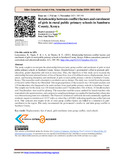Relationship between conflict factors and enrolment of girls in rural public primary schools in Samburu County, Kenya
Date
2023-11-21Author
Lanyasunya, Ropilo
Ngala, Fredrick B. J. A.
Tikoko, Betty Talai
Metadata
Show full item recordAbstract
The study sought to investigate the relationship between inter-group conflict and enrolment of girls in rural
public primary schools in Samburu County, Kenya. Despite Kenya’s government’s effort to promote girls’
education, gender disparities still exist in rural areas. Thus, the objectives of this study are to examine the
relationship between selected factors of loss of human lives, loss of livelihood source, displacements, fear of
attack, and learning disruption and enrolment of girls in rural public primary schools in Samburu County,
Kenya. The researcher used a descriptive correlation survey design. The study was viewed from the premise
of Social Conflict Theory by Oberschall. The target population of the research was 136 female teachers and
135 headteachers who happened to be male teachers from rural public primary schools in Samburu County.
The sample size for the study was 136 female teachers and 27 headteachers. Out of these, 14 female teachers
and 3 headteachers were used for piloting. The researcher used the census method for female teachers who
responded to the questionnaires, and a purposive sampling technique was applied for head teachers whose data
was obtained using interview schedules. The Pearson Correlation Coefficient showed a statistically significant
moderate negative correlation of -0.537 with a p-value (Sig.) of 0.005, indicating significance at the 5 per cent
level. This indicates that higher levels of inter-group conflict factors are linked to a reduction in girls’
enrollment in the region. The study recommends the government’s resolve to end inter-group conflict in
Samburu County

